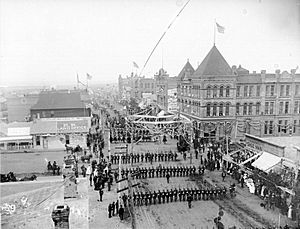Enabling Act of 1889 facts for kids
The Enabling Act of 1889 was an important law passed by the United States government on February 22, 1889. This law made it possible for four new states to join the United States. These states were Montana, Washington, North Dakota, and South Dakota.
Before this act, North and South Dakota were part of one large area called the Dakota Territory. The Enabling Act split this territory into two separate states. The border between them was set along a specific line. The main cities chosen for their first state meetings were Bismarck for North Dakota and Pierre for South Dakota.
Contents
Becoming a State: What the Act Did
This act gave people living in these areas new rights. They could now vote for their state leaders. They could also choose people to represent them at special meetings called political conventions. These meetings helped set up the new state governments.
Choosing Representatives for Congress
Soon after the act passed, the new states held elections. They voted for people to represent them in the United States House of Representatives. This is part of the U.S. government that makes laws. Montana, Washington, and North Dakota each got one representative. South Dakota got two because it had more people living there.
Creating State Constitutions
Each new state needed its own set of rules, called a constitution. North Dakota's constitution was simpler to create. South Dakota had a special way of approving its constitution. People voted "For the Sioux Falls constitution" or "Against the Sioux Falls constitution." If most people voted against it, the constitution would be changed until it was approved.
New Rules for New States
The Enabling Act also set some important rules for the new states. These rules helped make sure everyone was treated fairly.
Religious Freedom for Everyone
One key rule was about religious freedom. The act said that no one in these new states could be treated badly because of their religion. Everyone had the right to believe what they wanted.
Public Land and Education
The act also changed who owned certain lands. All public land in these territories became property of the government. This included Indian reservations and other unclaimed areas.
The new states had to pay back any money their territories owed. In return, the federal government promised to help with education. They would support public schools in these states. These schools had to be open to all children. They also had to be free from any unfair treatment or discrimination.
Funding Public Schools
Land set aside for public education had to be sold for at least ten dollars per acre. All the money from these sales went into a special fund. This fund was used to build and support the education system. No private companies or people could claim this land. It belonged to the government for public use.
Dividing Dakota Territory's Assets
Representatives from North and South Dakota met in Bismarck. They decided on the exact border between the two new states. They also had to divide other things. This included public records, any money the territory owed, and other property. Each new state was responsible for its share of the old territory's debts.


